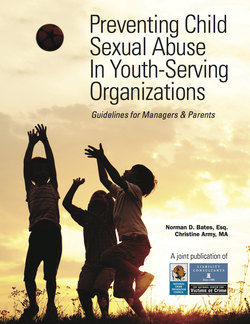Читать книгу Preventing Child Sexual Abuse In Youth-Serving Organizations - Norman D. Bates - Страница 4
На сайте Литреса книга снята с продажи.
Interpreting the Data
ОглавлениеEstimating how many children are being or have ever been sexually abused is problematic. Some of the challenges that are faced include: inconsistent state definitions of child sexual abuse, under and non-reporting, a variety of report receiving/data collecting agencies and how the data is reported.
1.Inconsistent State Definitions of Child Sexual Abuse
There is no single definition of child sexual abuse used currently. States vary in what age is considered a “child” as well as who can legally be held responsible for child sexual abuse.
2.Under and non-reporting
Many cases of child sexual abuse are not reported right away and some are never reported. Therefore, the actual number of children who are or have ever been sexually abused is currently unknown.
3.Report receiving agencies
Depending upon how a state defines child sexual abuse, usually reports will be reported to either local law enforcement or Child Protective Services (CPS). However, many instances of sexual abuse never reach these agencies and are dealt with internally by the organizations and/or individuals involved.
4.Data collecting agencies
There are a number of agencies that collect data on child sexual abuse. The National Child Abuse and Neglect Data System (NCANDS), the data collecting system of the National Data Archive on Child Abuse and Neglect (NDACAN), gathers information from participating CPS agencies. However, they do not collect data from local law enforcement. This means that current data collecting systems only capture a portion of the total incidents of CSA.
5.How the data is reported
Understanding the scope of child sexual abuse means taking into account both prevalence and incidence rates.
The number of child sexual abuse cases will be reported in one of two ways: incidence or prevalence. “Incidence rates are based on how many children were abused in a single year. Prevalence rates are based on a lifetime or a full childhood, such as what percentage of all children were ever abused.”3
Data from the CDC in 2006 indicates that 1 in 4 women and 1 in 6 men were sexually abused before the age of 18.4
The data regarding child sexual abuse can be confusing. Consequently, this can lead to inconsistent data reports as shown by the following statistics.
Data: CDC Study, 2006
•According to the publication “Child Maltreatment” published by NCANDS, data gathered from participating Child Protective Services agencies in 2011 indicates that of all cases received and screened in, 9.1% were sexual abuse cases.5
•In 2006, the Centers for Disease Control (CDC) conducted an adult retrospective study that estimated that 1 in 4 women (25%) and 1 in 6 men (17%) were sexually abused before the age of 18.6
•Prevalence rates used by some professionals in the field range from 8% to 20%.7
•One in 5 girls (20%) and 1 in 20 (5%) boys are the victim of child sexual abuse.8
•The 2003 National Institute of Justice report stated that 3 out of 4 victims (75%) of child sexual abuse have been sexually victimized by someone they knew well.9
•Bureau of Justice Statistics report that 1.6% of children between the ages of 12-17 are the victims of rape/sexual assault.10
•A 2001 National Child Victimization Survey estimates that 1.9 per 1,000 children (0.19%) aged 12-17 are raped/sexually assaulted.11
The severity of the incidence and prevalence of an issue often determines how much public attention and help it will receive. Before something can be fixed, the scope of the problem must be known.
